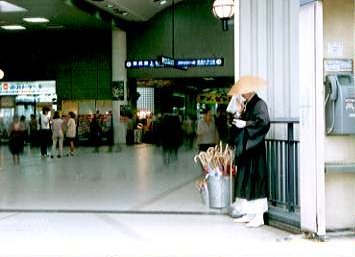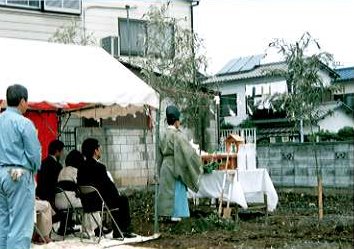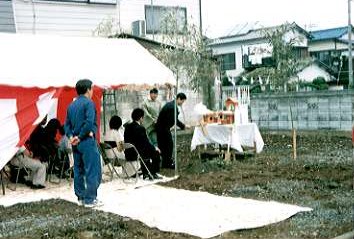

| To Everyday Scenes 2 |
| Many of you have probably seen tons of exotic pictures featuring old temples, shrines, castles and thatch-roofed houses or busy shopping scenes and train stations. So here in this page, I would like to take you on a virtual trip to plain, ordinary and possibly dull places in the Tokyo area that you can't normally experience through reading travel guides. |
| These are pictures of a
supermarket and a shopping center near my house. It used to be that if
you needed fish, you went to a fish shop, and if you wanted vegetables
or fruit, you went to a grocery store. But now, you can kill 2 birds (3
or 4 or lot more) with one stone. You just go to a supermarket. Until about
the early 90s, the law named Daikibokobaitenhoo that restricts big retail
shops from opening, in order to protect privately owned small businesses,
was very strict. But as a result of the Structural Impediments Initiative
Talk*** between Japan and the U.S, the law has been eased a lot and many
supermarkets have been opened in the last few years.I have heard some people
express their disappointment in the trend because those small privately
owned stores often provide them with good opportunities to communicate
with others. ***It was a series of talks held between Japan and the U.S.A that discussed the trade imbalance between the two and Daikibokjobaitenhoo was one of the things that was named by the U.S government as being an obstacle to fair trade. |
| It's been said for quite some time that the age of two car families has arrived! It seems everyone over the age of 18 owns one. Considering the size of this country and the number of people living in it, two cars in one household is (in my opinion) a little too much; however, the number of cars here is still increasing. One thing, though, that should not be forgotten about in this modern high tech age is our great old friend the bicycle. One statistic from 1997 shows that while ownership rate (all household) for cars is 82.6%, bicycle ownership is 81.5% (although it seems to me that every single household owns at least one bicycle)and the gap between the two figures is expected to become wider. However, bicycles are still loved by a great number of people here in Japan. They are used not only as a tool for exercising but also, and much more impotantly, as a simple means to move from point A to B - showing how closely they are related to the lives of Japanese people. |
If you walk for about, say, 30 minutes
in a countryside , you are likely to come across at least one or two stone
carvings. It must be one of dosojin, jizo or bato kannon. The pictures
on the left are of bato kannnon, a god that people worshiped as a Guardian
God of horses. They were built to pray for the horses' well-being , as
they were very important in many aspects of people's lives. They are also
viewed as divine creatures that bridge this world with the world of gods.
Often these are built on the sites on which a horse has died. |
| A monk standing at a train
station trying to raise some money. This is part of a religious activity
called "Takuhatu",in which monks go to a city and give people
blessings.(Usually monks go door to door giving people blessings, getting
money in return, instead of just standing at one place like this.) It is
usually practiced by monks who belong to the Zen sect (see Culture lessons)of
Buddhism. It is hard to see in the pictures, but the monk is holding a
wooden bowl in his left hand for people to put money in. It used to be
that people put food in the bowl, but this practice doesn't exist anymore,
except for in a few regions. |
 I
wonder what he is thinking (or chanting?).... I
wonder what he is thinking (or chanting?).... |
 |
I don't know... somehow seeing him standing there gives me the sense of comfort. |
| These pictures are of a groundbreaking ceremony held in my neighborhood. A groundbreaking ceremony in Japan is usually carried out by a Shinto priest and follows a certain ritual. |
 |
He is chanting something to purify the land and bring down a god. Look at his costume
|
|
 One of the family members is doing a ritual called Kuwaire. |
| Hundreds of young people's lives have been lost because of the fierce competition created by Juken (taking entrance exams for college, high school or junior high school). For some young people, the pressure put on them to get into a good high school or college is too much to bear and they have committed suicide. Why is the competition so tough? It can be attributed to a few things but one of the major factors is that how well (or how poorly) they do at those exams pretty much determines their future. Which high school you go to almost decides which college you go to and then, of course, depending on which college you study at (often NOT WHAT YOU STUDIED and how well you did), you have more job opportunities to choose from. Besides that, going back to school once you get into the real world is almost unthinkable. Middle-aged students in Japan are virtually non-existent. This also adds to the pressure. |
| The school entrance system has been under fierce attack from critics for quite some time for placing too much stress on a student's academic record and entrance exam score, rather than on the student's overall performance that includes athletic and artistic abilities as well as extra-curricular activities such as volunteer work. Although things are changing and more and more high schools and colleges are now adopting new criteria in accepting students, the fact still remains that young people's futures are set more or less when they get into a high school or college. |
| To Everyday Scenes 2 |
| HOME |
![]()